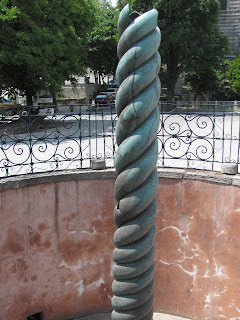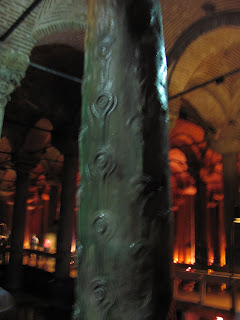In the foreground, the Egyptian Obelisk dates from about 1500 BC and was brought to Constantinople from Luxor in Egypt. It originally stood much taller, maybe as much as 3 times its current height. In the background, another obelisk is undergoing restoration. The second obelisk was heavily damaged over the years, as members Janissary corps liked to prove their bravery by climbing to the top.
The Egyptian Obelisk sits on a base dating from the 4th century AD. It depicts Emperor Theodosius I and his family enjoying chariot races in the Hippodrome. I love the scene (on the bottom of the 2nd picture) of the obelisk being erected in its current location.
This twisted bronze column used to be crowned by three snake heads. It is thought to the 5th century BC and was brought to Constantinople from Delphi, Greece. In the 18th century a drunk Polish nobleman beheaded the column.
Located near the east end of the Hippodrome, this lonely stone pillar is all that is left of the Milion, the gateway from which all distances in the Empire were measured.
It was getting quite hot in the afternoon and I decided it would be a good day to visit the nearby Basilica Cistern. This hauntingly beautiful underground chamber was built by the Emperor Justinian in 532 to supply water to the Byzantine Palace. Rows upon rows of classical columns support the undulating roof arches. Though it was never meant to be seen by the public, the builders of the cistern seemed to take aesthetic elements into consideration.
In one corner of the cistern, two columns are supported by Medusa heads. Medusa images and statues were sometimes buried or hidden in buildings to ward off evil. However, no one knows why one head was placed sideways and one upside down.
After the conquest of the city, the Ottomans remained unaware of the existence of the cistern for a century. It was only rediscovered after residents were found to be collecting water and fish via buckets lowered through holes in their floors.
In animal news, I had my fortune told by a rabbit today. I'm not usually one for tourist traps, but this guy found my weak spot. He has one of his rabbits or his rooster pick a slip of paper from a tray. Mine reads: "You wil have good news and be very happy very soon. You succeed everything you attempt. If you acaquired wealth, you will get it even if it's a bit delayed."












No comments:
Post a Comment